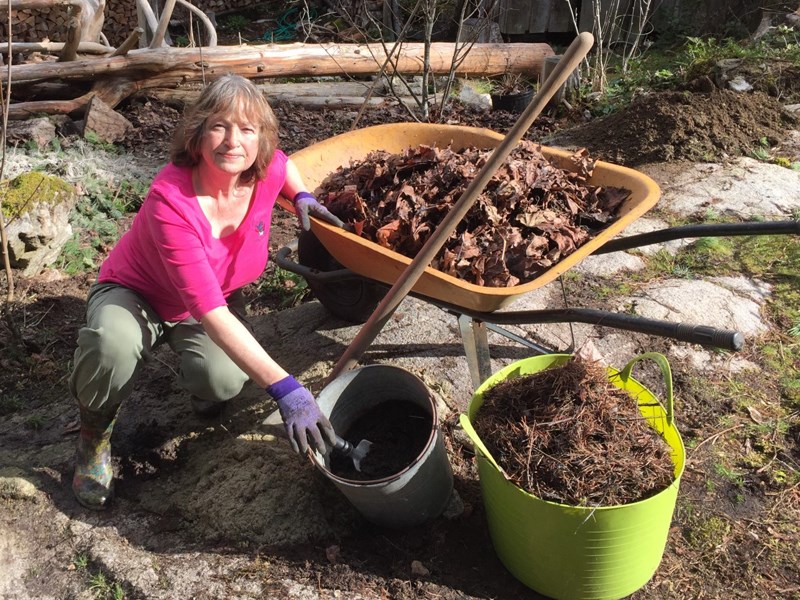A plant needs certain things to grow successfully: sun, air, water, nutrients, and some say, kind words.
Sunlight is already provided. We can add grow lights, but for the most part plants get what they need from the sun. Air is provided also, free of charge. Plants exchange oxygen for carbon dioxide, which is a bonus for us oxygen-dependent creatures. Water and nutrients are present in most soils, but not necessarily enough or in the right proportions, or in an easily assimilated form. That is where we come in.
Soil nutrients need to be soluble in order to be taken up by the roots, and the most voracious feeders are the very fine, hair-like roots. Roots can’t handle chunky food. Their food processors are the enzymes and microorganisms in the soil which break down molecules into a form the roots can absorb. Water is the vehicle that transports the nutrients into the plant. Oxygen is a necessary component for photosynthesis and the assimilation of soil nutrients. It is taken from the soil as well as the air.
How do we give our plants what they need? We do that by creating a soil environment that maximizes the plant’s ability to access what it needs.
We use amendments to improve the physical characteristics of our soil. We don’t want hard, compact soil. Opening up the soil improves drainage, moisture retention and aeration. Loose soil can stay moist, providing water to roots, while being open enough to hold air. Soil that is loose and open also allows excess water to percolate through so that the roots are not waterlogged and starved of oxygen. Opening up the soil also allows roots to grow and travel freely through the soil. A better root structure means a larger healthier plant.
At the same time, this open porous soil prevents erosion by minimizing run-off. What you have is a giant sponge that drains into the deeper groundwater levels. You can change the physical nature of your soil by adding soil amendments. -These are essentially sand and humus, and the physical act of digging and cultivating.
Coarse sand can help open up heavy clay or bog soil by incorporating larger particles with the finer clay or peat soil. It is like bran in your cereal: little nutrient value, but so beneficial.
Digging is a very physical soil treatment. Even the nicest garden soil can suffer from compaction and get root crowded. Digging manually loosens the soil and enables you to remove stones, roots and obstructions. That is part of the benefit you get whenever you dig up, divide and replant in the ordinary course of gardening.
That being said, excess digging disturbs the normal environment of soil microorganisms that work happiest in specific environments. Some operate in the upper, oxygen-rich level, others do better deeper down, and when you dig intensively the natural order is disturbed and takes a while to adjust. A humus rich soil should require little digging.
Humus is the organic component to your soil. Frankly, you can’t have too much. This comes from compost, manure, leaves, pine needles, grass, seaweed, bark, peat; in other words, plant (organic) matter.
Organic additions have a lower nutrient value than prepared fertilizers. Compare the number rating on bagged compost or manures to a commercially prepared fertilizer. You would see probably 1-1-1, as opposed to 6-8-6, or other rated fertilizers.
However, that’s not why we add humus. What is important about these organic additions is how they affect the consistency of the soil. Humus gives you moisture retention and an open soil texture. Soil with a good humus content is spongy, loose and moist, demonstrated by squeezing a handful in your fist. It should ball up loosely, breaking up as it is released. Heavy soil binds into a tight ball and does not crumble freely. Sandy, dry soil does not bind together, but crumbles too freely. Neither condition makes for a desirable growing medium.
Humus does more than work on the physical nature of soil. Even more important is how it feeds the microorganisms in the soil and provides enzymes. It is through the action of these tiny organisms and enzymes that the soil nutrients are broken down into a form that can be taken up by plants. You are in effect feeding your soil and keeping it fit and healthy.
When talking about soil it is important to mention pH. This refers to the acidity or alkalinity of a soil and influences how the roots are able to process nutrients. Most plants do best in a mildly acid soil, and some prefer it more so, such as tomatoes, roses, rhododendrons and most berries. The soil here in coastal BC tends to be acid, so liming is a matter of course, but don’t over do it. The easiest way to adjust a too-acid soil is to add lime. A slow acting or pelleted form is best, and applying it early in the season gives it a chance to percolate through the soil before planting.
Fertilizers can give your soil a boost, but the fertilizer you use is only as effective as your soil’s ability to process it so that the plants’ roots can assimilate it. Otherwise, that investment in fertilizer is not going to give you the yields you expect. Instead, be generous with your soil amendments, be extravagant with your mulch, overindulge with humus and reap the rewards of a healthy rich garden soil. Now, going back to that statement about the needs of soil—the kind word—it can’t hurt!
Lin Morrison is a member of Powell River Garden Club.



